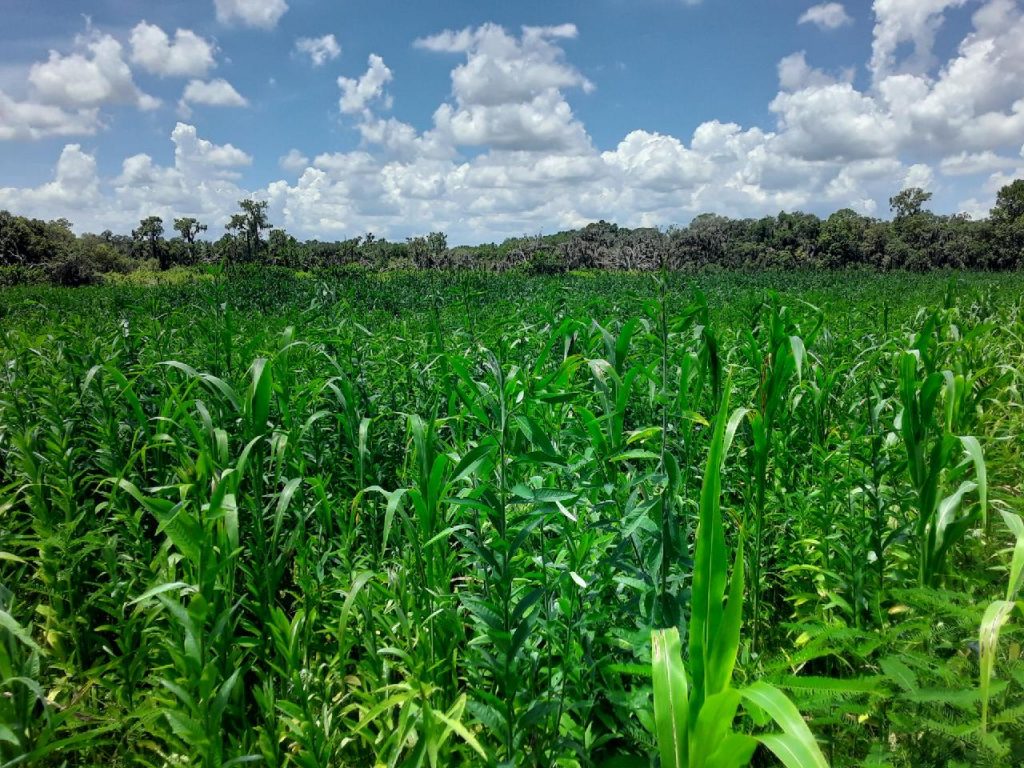
By Tiffany Bailey and Ida Vandamme
It was about 18 months ago when we began planning our first crop to be planted on our newly certified organic field at Honeyside Farms in Parrish, Florida. The field was previously used for pastureland. It was easy to see that we would be starting from a soil structure that is common in our area: very sandy with low amounts of existing organic matter. We quickly learned that building these soils would need to become a priority.
It can be common for issues to surface during the first few months of converting from perennial pastureland to vegetable production, and that is exactly what we experienced. Our first major problem was due to the microbe populations living in the soil. We were tilling the land for the first time in possibly decades, and we believe that practice turned the existing microbial ecosystem on its head.
Without the introduction of good bacteria and fungi suited for vegetable farming, our organic crops were especially vulnerable to disease pathogens coming from infected seeds, neighboring farms and even on our equipment and shoes. It was a huge challenge! But, over time, we began to build up the proper microbe population for our farm. Planting cover crops proved to be an important part of building healthy soil.
COVER CROPS OFFER BIG BENEFITS
Cover crops are a very helpful tool in aiding and maintaining this transition. Unlike perennial pastureland, cover crops for vegetable farming are annual, covering the ground for a few months at a time (very convenient for your off season when it’s not practical to grow your main crop). Cover crops grow very fast, covering and protecting the soil from erosion.
Root mass grows down, infiltrating, breaking up compaction, improving structure and excreting exudates that condition the soil and attract good bacteria. Above ground, leaf matter adds literally tons of biomass that contributes to organic matter when broken down and attracts all kinds of beneficial insects and wildlife. There are so many more benefits to cover crops; these are just the main ones.
COVER CROP OPTIONS
Honeyside Farms has grown sorghum-sudangrass, sunn hemp, buckwheat and cowpeas for cover crops. As an organic farm, we preferably use organic seed. However, organic cover crop seed is not always widely available. Most certifying agencies will make exceptions when certified organic seed is not available.
Sunn hemp is probably our favorite cover crop. According to a Sustainable Agriculture Research and Education publication, sunn hemp can produce 5,000 pounds of dry matter per acre and 120 pounds of nitrogen per acre. That’s enough slowly available nitrogen to feed some crops from start to finish without needing to add any extra nitrogen.
Sorghum is also very beneficial. The sorghum-sundangrass hybrid is more productive in biomass and leaf matter, which is more beneficial as a cover crop than grain sorghum. Sorghum-sudangrass has been recorded to produce up to 18,000 pounds of dry matter per acre. The roots are perfect for scavenging any leached nutrients from the previous crop and putting them within reach of the next crop, thus minimizing pollution and making effective use of nutrition. Sorghum is also known to suppress diseases and nematodes by breaking up their life cycle and producing compounds toxic to them.
Cowpea is a legume. As a climber, it can be a nice addition to any tall cover crop mix like sunn hemp and sorghum. We have seen that cowpeas and buckwheat can provide significant sources of nectar and food for beneficial insects that we want to attract to the farm. Buckwheat acts as a great short-term cover and easily breaks down. It’s perfect for the 40- to 50-day gap between crops when other covers would take too long.
COVER CROP MANAGEMENT
When planting, it’s important to broadcast the proper amount of seed per acre. If the seed is planted too thin, one can miss out on biomass production. But there is no need to waste seed and money planting too thick. Before applying any fertilizer to the cover crops, we take samples and follow what the soil report recommends at planting.
The best time to knock down the cover crop is when the biomass is optimized, but before the carbon-to-nitrogen ratio gets too high and before seed set to prevent weeds. We allow a few weeks to let the cover crop break down enough so that it is not tying up nitrogen that should be available for our main crop. Sometimes before planting a cover crop, we can tell that this timing will not match when we need the field ready to grow a crop. But we find it better to still plant cover crops and gain some of the benefits rather than let the land sit bare and gain nothing or possibly even lose valuable soil due to erosion. Allow a few weeks to let the cover crop break down enough that it is not tying up nitrogen that should be for your main crop.
Most challenges come from what is limited by resources, time and practicality. Nothing will be gained if no time is taken to plan for cover crop management. But with proper intention and planning, planting cover crops will provide long-term benefits for many seasons to come.









